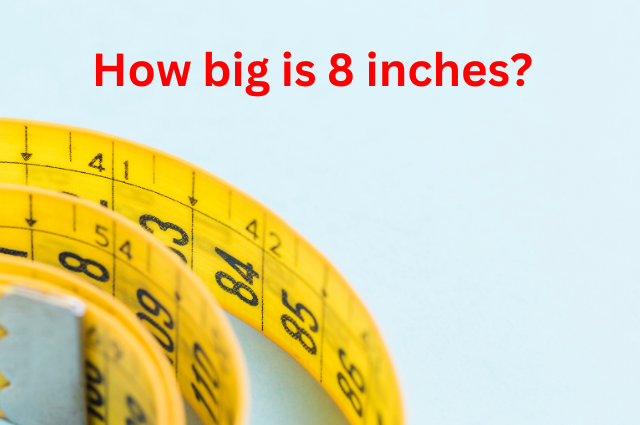
8 inches is about the length of an average adult’s hand, from the tip of the middle finger to the base of the palm. It’s also roughly the size of a typical tablet or e-reader screen, like the ones you use for reading or watching videos. Basically, it’s a common measurement for things that are portable and hand-held.
The Concept of Measurement
When talking about measurement, we’re figuring out how much of something there is by comparing it to a known standard. We measure different things like length, weight, volume, time, and temperature. Each type of measurement has its own unit, like inches for length or grams for weight.
To measure things, we use tools that are set up to a specific unit. Like a ruler measures length in inches, and a scale measures weight in grams. Being accurate with measurements is important in areas like science, medicine, and engineering. It helps us make precise observations and understand the world around us better.
Why are accurate measurements so important?
Precision: Accurate measurements help us be precise in our calculations and decision-making. In some jobs, even tiny measurement mistakes can cause big problems, so being spot-on is important.
Consistency: Imagine trying to compare data or results, but the measurements are all over the place. Accurate measurements make sure things stay consistent and reliable. It’s like having a trustworthy ruler for all your experiments and projects.
Safety: Accuracy is a safety superhero. In construction, if measurements are off, buildings could be shaky and unsafe. In medicine, wrong measurements could mean the wrong dose or treatment. Accuracy keeps things safe.
Cost-effectiveness: Getting measurements right can save a bunch of money. It helps companies avoid making too much or too little of something, cutting down on waste and saving costs. It’s like using just the right ingredients when you’re cooking.
Innovation: Think of accurate measurements as the secret sauce for new ideas and inventions. Scientists and researchers need precise measurements to make smart decisions, leading to great discoveries and new technologies. It’s like having an accurate map to explore new territories.
How Big is 8 Inches in Centimeters?
To figure out how big 8 inches is in centimeters, you need to know that 1 inch equals 2.54 centimeters. So, you multiply 8 inches by 2.54 to get the size in centimeters.
Here’s the math:
8 inches x 2.54 centimeters per inch = 20.32 centimeters
So, 8 inches is about 20.32 centimeters. If something is 8 inches long, it’s approximately 20.32 centimeters when measured using the metric system. This is handy to know, especially if you’re dealing with measurements from different countries that use either inches or centimeters.
Also Read: How Big is 8×10 Picture?
How Big is 8 Inches in Millimeters?
To convert inches to millimeters, we use the fact that 1 inch is approximately equal to 25.4 millimeters. So, to find out how big 8 inches is in millimeters:
8 inches × 25.4 mm/inch = 203.2mm
8inches×25.4mm/inch=203.2mm
Therefore, 8 inches is equal to 203.2 millimeters.
How Big is 8 Inches in CM
To convert inches to centimeters, you can use the conversion factor of 1 inch being approximately equal to 2.54 centimeters. So, for 8 inches:
8inches × 2.54 cm/inch = 20.32 cm
8 inches×2.54cm/inch=20.32cm
Therefore, 8 inches is equal to 20.32 centimeters.
How Big is 8 Inches Pizza?
When we talk about the size of a pizza, we’re usually referring to the diameter, which is the distance across the pizza from one edge to the other, passing through the center. If we consider a circular pizza with an 8-inch diameter:
The formula for the diameter (D) of a circle is related to its radius (r) by D=2r.
So, for an 8-inch pizza:
D=8 inches
However, if you’re interested in the area of the pizza (how much space it covers), you can use the formula for the area (A) of a circle:
A=πr^2
For an 8-inch pizza:
r=D/2 =8/2 =4 inches
A=π(4^2)≈50.27square inches
So, an 8-inch pizza has a diameter of 8 inches and covers approximately 50.27 square inches.
Visualizing 8 Inches
To help you imagine 8 inches:
- An average adult hand is around 8 inches long.
- A tablet or e-reader screen is about 8 inches diagonally.
- A standard sheet of paper is a bit longer than 8 inches.
- A brick is usually 8 inches wide.
- A medium-sized cucumber is roughly 8 inches long.
- It’s just a bit longer than a pencil.
8 Inches in Construction and Architecture
In construction, 8 inches is a common size for various materials:
- Concrete blocks are often 8 inches tall.
- Standard bricks are about 8 inches long.
- Lumber that’s 8 inches wide is used for beams and posts.
- Insulation is often 8 inches thick.
- Steel beams can be 8 inches wide.
- Concrete footings are commonly 8 inches thick.
8 Inches and Clothing Sizes
In clothing, an 8-inch difference can be a game-changer. It might mean needing a specific size or style for a good fit.
- Pant sizes might vary based on an 8-inch difference between waist and inseam.
- Different brands have different sizing charts.
- Consider “tall” or “petite” sizes if you have significant measurement differences.
8 Inches in Technology
In the tech world, 8 inches is often used to describe screen sizes:
- Tablets and e-readers often have an 8-inch screen.
- Portable monitors might be 8 inches in size.
- It’s also a measurement for electronic devices or components.
Conclusion
Understanding the size of 8 inches matters in various situations. Whether you’re shopping for clothes, working in construction, or using electronic devices, knowing what 8 inches looks like helps you make informed decisions.







